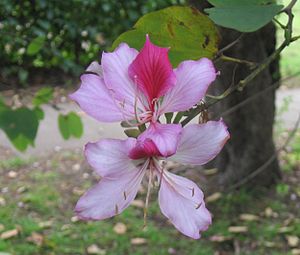Note: This is a project under development. The articles on this wiki are just being initiated and broadly incomplete. You can Help creating new pages.
Bauhinia variegata - Kaancanara
Kaancanara consists of the dried, stem bark of Bauhinia variegata Blume (Fam.Leguminosae): a medium sized tree occurring in sub-Himalayan tract extending eastwards to Assam, Eastern, Central and South India. [1]
Contents
- 1 Uses
- 2 Common names
- 3 Chemical Composition
- 4 Properties
- 5 Habit
- 6 Identification
- 7 List of Ayurvedic medicine in which the herb is used
- 8 Where to get the saplings
- 9 Mode of Propagation
- 10 How to plant/cultivate
- 11 Commonly seen growing in areas
- 12 Photo Gallery
- 13 References
- 14 See also
- 15 External Links
Uses
Thyroid disorders, Cancer, Goitre.
Common names
| Language | Common name |
|---|---|
| Kannada | Keyumandar, Kanchavala |
| Hindi | Kachanar, Kanchanar, Kachnar |
| Malayalam | Chuvanna Mandharam |
| Tamil | Sigappu mandarai, Sihappu mantarai |
| Telugu | Deva Kanchanam |
| Marathi | Kanchana, Raktakancana |
| Gujarathi | Champakati, Kanchnar, Kachnar |
| Punjabi | Kanchnar |
| Kashmiri | Kalad |
| Sanskrit | Kaancanaraka |
| English | Mountain Ebony |
Chemical Composition
Tannins.
Properties
Reference: Dravya - Substance, Rasa - Taste, Guna - Qualities, Veerya - Potency, Vipaka - Post-digesion effect, Karma - Pharmacological activity, Prabhava - Therepeutics.
Dravya
Rasa
kashaya
Guna
Laghu, Ruksha,
Veerya
Sheeta (cold)
Vipaka
Katu
Karma
Deepana, Grahi, Tridoshahara, Gandharvaddihara
Prabhava
Habit
Identification
Leaf
| Kind | Shape | Feature |
|---|---|---|
| Simple | Bilobed | Leaves petiolate, petiole 2-3.8 cm long; lamina c. 4.5-15 cm long, as broad as or rather broader than long, with a medium cleft reaching from 1 /4 to 1/3 the way down, lobes obtuse, the base is deeply heart shaped, 9-15 nerved, pubescent beneath when young |
.[2]
Flower
| Type | Size | Color and composition | Stamen | More information |
|---|---|---|---|---|
| bisexual | 5-7cm long | purple–pink | few flowered pubescent raceme. Pedicel short or absent, bracteole minute; hypanthium slender, c. 1.2-2.5 cm long. Calyx 2.0-2.7 cm long, tomentose, 5 toothed at the apex. Petals 5-6.3 cm long, obovate, with long rather broad claw, all white or 4 petals pale purple and fifth darker with purple veins. Stamens 5, fertile, no staminodes. Ovary hairy, stipe 10-17 mm long; style long, stigma capitate. |
Fruit
| Type | Size | Mass | Appearance | Seeds | More information |
|---|---|---|---|---|---|
| Pod | 15.0-30 cm long, c. 1-2.5 cm broad | hard, flat, dehiscent 10-15 seeded; stipe glabrous. | {{{6}}} |
Other features
List of Ayurvedic medicine in which the herb is used
Where to get the saplings
Mode of Propagation
How to plant/cultivate
Commonly seen growing in areas
Western himalayas, Open woodland, Moisty soil area.
Photo Gallery
References
- ↑ THE AYURVEDIC PHARMACOPOEIA OF INDIA, PART-I, VOLUME-1, page no 56.
- ↑ Plant morphology
See also
External Links
Categories:
- Ayurvedic Herbs known to be helpful to treat Thyroid disorders
- Ayurvedic Herbs known to be helpful to treat Cancer
- Ayurvedic Herbs known to be helpful to treat Goitre
- Herbs with common name in Kannada
- Herbs with common name in Hindi
- Herbs with common name in Malayalam
- Herbs with common name in Tamil
- Herbs with common name in Telugu
- Herbs with common name in Marathi
- Herbs with common name in Gujarathi
- Herbs with common name in Punjabi
- Herbs with common name in Kashmiri
- Herbs with common name in Sanskrit
- Herbs with common name in English
- Habit - Tree
- Index of Plants which can be propagated by Seeds
- Herbs that are commonly seen in the region of Western himalayas
- Herbs that are commonly seen in the region of Open woodland
- Herbs that are commonly seen in the region of Moisty soil area
- Herbs
- Fabaceae





